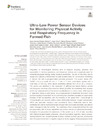Identificador persistente para citar o vincular este elemento:
https://accedacris.ulpgc.es/jspui/handle/10553/69945
| Título: | Ultra-low power sensor devices for monitoring physical activity and respiratory frequency in farmed fish | Autores/as: | Martos-Sitcha, Juan Antonio Sosa González, Carlos Javier Ramos-Valido, Dailos Bravo, Francisco Javier Carmona Duarte, C. Gomes, Henrique Leonel Calduch-Giner, Josep Àlvar Cabruja, Enric Vega Martínez, Aurelio Ferrer, Miguel Ángel Lozano, Manuel Montiel-Nelson, Juan Antonio Afonso, Juan Manuel Pérez-Sánchez, Jaume |
Clasificación UNESCO: | 3307 Tecnología electrónica | Palabras clave: | Aquaculture Fish Welfare Oxygen Consumption Physical Activity Respiratory Frequency, et al. |
Fecha de publicación: | 2019 | Publicación seriada: | Frontiers in Physiology | Resumen: | Integration of technological solutions aims to improve accuracy, precision and repeatability in farming operations, and biosensor devices are increasingly used for understanding basic biology during livestock production. The aim of this study was to design and validate a miniaturized tri-axial accelerometer for non-invasive monitoring of farmed fish with re-programmable schedule protocols. The current device (AE-FishBIT v.1s) is a small (14 mm × 7 mm × 7 mm), standalone system with a total mass of 600 mg, which allows monitoring animals from 30 to 35 g onwards. The device was attached to the operculum of gilthead sea bream (Sparus aurata) and European sea bass (Dicentrarchus labrax) juveniles for monitoring their physical activity by measurements of movement accelerations in x- and y-axes, while records of operculum beats (z-axis) served as a measurement of respiratory frequency. Data post-processing of exercised fish in swimming test chambers revealed an exponential increase of fish accelerations with the increase of fish speed from 1 body-length to 4 body-lengths per second, while a close relationship between oxygen consumption (MO2) and opercular frequency was consistently found. Preliminary tests in free-swimming fish kept in rearing tanks also showed that device data recording was able to detect changes in daily fish activity. The usefulness of low computational load for data pre-processing with on-board algorithms was verified from low to submaximal exercise, increasing this procedure the autonomy of the system up to 6 h of data recording with different programmable schedules. Visual observations regarding tissue damage, feeding behavior and circulating levels of stress markers (cortisol, glucose, and lactate) did not reveal at short term a negative impact of device tagging. Reduced plasma levels of triglycerides revealed a transient inhibition of feed intake in small fish (sea bream 50-90 g, sea bass 100-200 g), but this disturbance was not detected in larger fish. All this considered together is the proof of concept that miniaturized devices are suitable for non-invasive and reliable metabolic phenotyping of farmed fish to improve their overall performance and welfare. Further work is underway for improving the attachment procedure and the full device packaging. | URI: | https://accedacris.ulpgc.es/handle/10553/69945 | ISSN: | 1664-1078 | DOI: | 10.3389/fphys.2019.00667 | Fuente: | Frontiers in Physiology [ISSN 1664-1078], v. 10, p. 1-14 |
| Colección: | Artículos |
Citas SCOPUSTM
34
actualizado el 08-jun-2025
Citas de WEB OF SCIENCETM
Citations
30
actualizado el 08-jun-2025
Visitas
99
actualizado el 10-ene-2026
Descargas
80
actualizado el 10-ene-2026
Google ScholarTM
Verifica
Altmetric
Comparte
Exporta metadatos
Los elementos en ULPGC accedaCRIS están protegidos por derechos de autor con todos los derechos reservados, a menos que se indique lo contrario.
